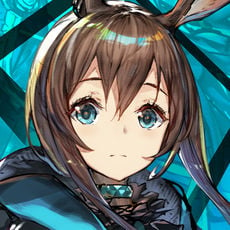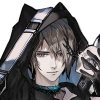Introduction and credits
(Mostly) translated from this brilliant analysis on Lofter with permission. Some parts (Pied Piper references and Celaiblason possibly being a wordplay on celebration) were discussed with Aca too.
Remember the previous Phantom analysis showing that Phantom has a lot more references than just Phantom of the Opera? His costume will have even more references to various things. Do keep in mind that most operators can and are likely to have multiple real life references. This is what I really like about Arknights.
Chinese server release trivia: Phantom of the Opera anniversary on 9 October
Screenshot of Maria Nearl trailer on the official Arknights Weibo account posted on 9 October 2020. This is where Phantom's costume was shown for the first time.
Phantom's costume was announced on 9 October 2020 on the trailer of Maria Nearl event. This is also the 34th anniversary of The Phantom of the Opera musical.
On 9 October 1986, this musical was first performed in London. It left a huge impression on musical lovers, and even touched the heart of someone at Hypergryph who is definitely a huge Phantom of the Opera fan. After all, there's so much detail in Phantom's character and the fact that the costume was announced on such a date.
Secrets of a Victorian man: Costume analysis
Initially I thought that Phantom’s clothes did not quite resemble the fashion at the end of the 19th century and looked more Italian. But after a closer look, it’s definitely Victorian, just that the type, colours, and model were too striking and caused this misunderstanding.
From Phantom’s Elite 2 to this costume, it gets even more elegant. The coordination is bolder, and of course it is an artist’s nightmare. For this new costume, Phantom has finally completely worn a standard suit for a Victorian man and it is very formal. But for some accessories and details, it can be seen that this cat is not an old-fashioned gentleman. He was a former actor, so he has to lead fashion trends.
Firstly, there is the innermost shirt. Although the new costume looks proper, but during the Victorian era, washing was not as convenient. To avoid showing spoilt looking collars, men would opt to buy fake collars and attach it outside the shirt.
No matter which illustration, he does not seem to be using a fake collar. Washing machines exist here. He looks like he is wearing a pleated shirt from his chest and wrist area. This kind of shirt is more of unofficial settings during the Victorian era. But secretly wearing a decorated top in those few layers, I give this dark show full marks.
Collar, left wrist, right wrist
From Phantom’s wrists, his shirt seem to have no buttonholes, or he chooses not to button it. In the Victorian era, there are not many accessories for men. At that time, watches were not trendy. Most wore rings, cufflinks, pocketwatches, or make a statement on the suit button or tie pin.
Just to mention, Phantom’s E2 art has a tie (it is not decorated, but taken from a suit), while the new costume has a scarf that goes down from the neck, which looks like a wide tie from that era. Except that it may not be like the real Victorian. Most scarves are secured by pins and have decorative purposes.
Left: E2 art with tie, Right: New costume has scarf with triangle pin
After wearing the shirt, the next layer is a vest. During Victorian times, even if the Western clothing was not so formal, a vest is a must. Phantom’s E1 and E2 art are too layered, so it is hard to tell whether he wears it or not. From the collar of E2 art, it looks like he is not wearing it. But he is definitely wearing it in the new costume. If his suit is open, then one can see if it is a single or double Albert pocket watch chain on the vest’s button hole. This shows if the other side of the watch chain has other accessories in the pocket of the vest.
Left: Single Albert, Right: Double Albert
But he has buttoned up his coat. According to normal logical deduction, as long as one does not specially show the pocket watch from the suit, there should not be any accessories.
Outside the vest is a Western coat. It's this huge slanted lapel and ruffled big lapel that made me wonder how this could be the style worn by Victorian men. Times have changed. To speak about clothing, mostly it’s the scarf, Western coat and its buttons, the triangle pin on the cloak and many belts. But it does not matter. Anyway those are ‘rags’ (t/n: probably a reference to what Skade said about Phantom’s clothes), as long as it looks good (Phantom’s coat is the most embellished out of all his clothes. Most likely this is due to his upbringing as an actor. The overall grey tone really suits him.) The Western suit in the new costume is the short type, and Phantom’s E2 Western coat looks like in between a tuxedo and a evening outfit. See also: SilverAsh’s winter costume in a similar style.
The final piece of the Western suit is the overcoat. Usually it is knee length or ulsters can reach the calf. There may be another shawl inside.
Left: Ulster long coat, Right: Phantom’s coat looks like a cloak at some part and the coat is the longest part
The final layer (which should be just for decoration), is the red shawl that is attached to the Western coat collar. (The end of the shawl seems to be sat on by Phantom). Western pants have nothing special besides the belt. Just that you can barely imagine how can fast redeploy wear such a suit without tearing it. What kind of material is this? I want it. The shoes are similar to the E2 ones, but the black ones are changed to dark grey. Who told you the gap is sexy?
After the clothes, the accessories will be discussed. Other than Phantom’s signature collar, the hat, gloves and staff are must haves for Victorian men from middle class and above. He is particular about his hat and gloves by not taking his gloves off no matter what. Including the hooded cloak in his initial illustration, E2 art both have hats.
The hat in E2 art looks like a fedora. The top goes down slightly and the sides curve up. (However, this kind of hat did not exist during the Victorian era. Maybe this is just for aesthetic purposes.) The new costume’s hat looks more like porkpie while the plague doctor’s hat is more like a top hat. Both are for more leisure purposes.
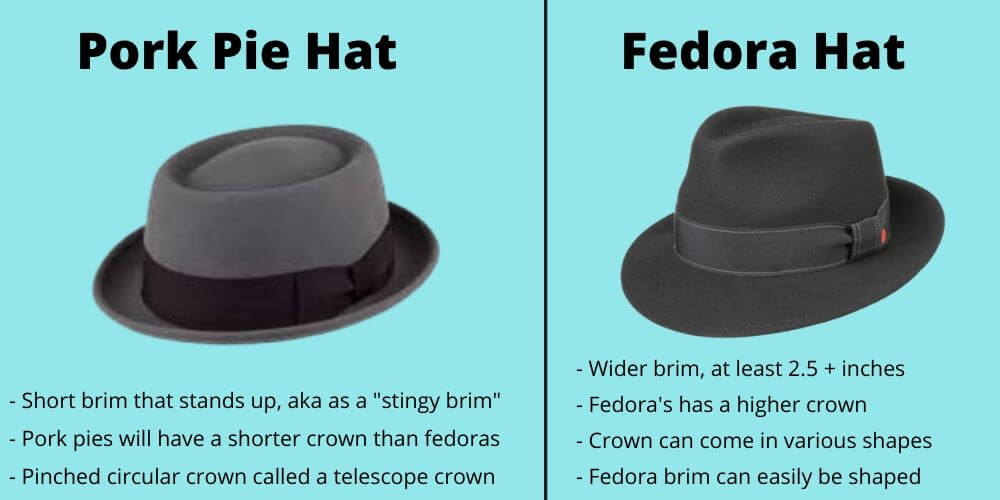
Phantom's mental world and plague doctor
After talking about the hot guy’s costume design, we can start looking at the overall picture. The content is my (OP’s) personal opinion. Because my knowledge is limited, so I welcome discussion.
The costume’s theme is Ghostbusters. I have not watched this, but Phantom’s air is really so dark. He can only be the ‘ghost’ to be caught. As the other three operators work together to unravel the mystery of the castle, the boss of the castle awaits.
But is the castle really a castle in this costume?
In the background of the costumes of Shaw, Mayer and Glaucus, this multimedia castle seems old and even in ruins from its appearance. The old castle looks more like a haunted house. But in Phantom’s costume, this haunted house is regal. The floor is shiny and well furnished. It looks like a new palace. But this scene is familiar. It has just appeared in Phantom’s own story as Phantom’s mental world.
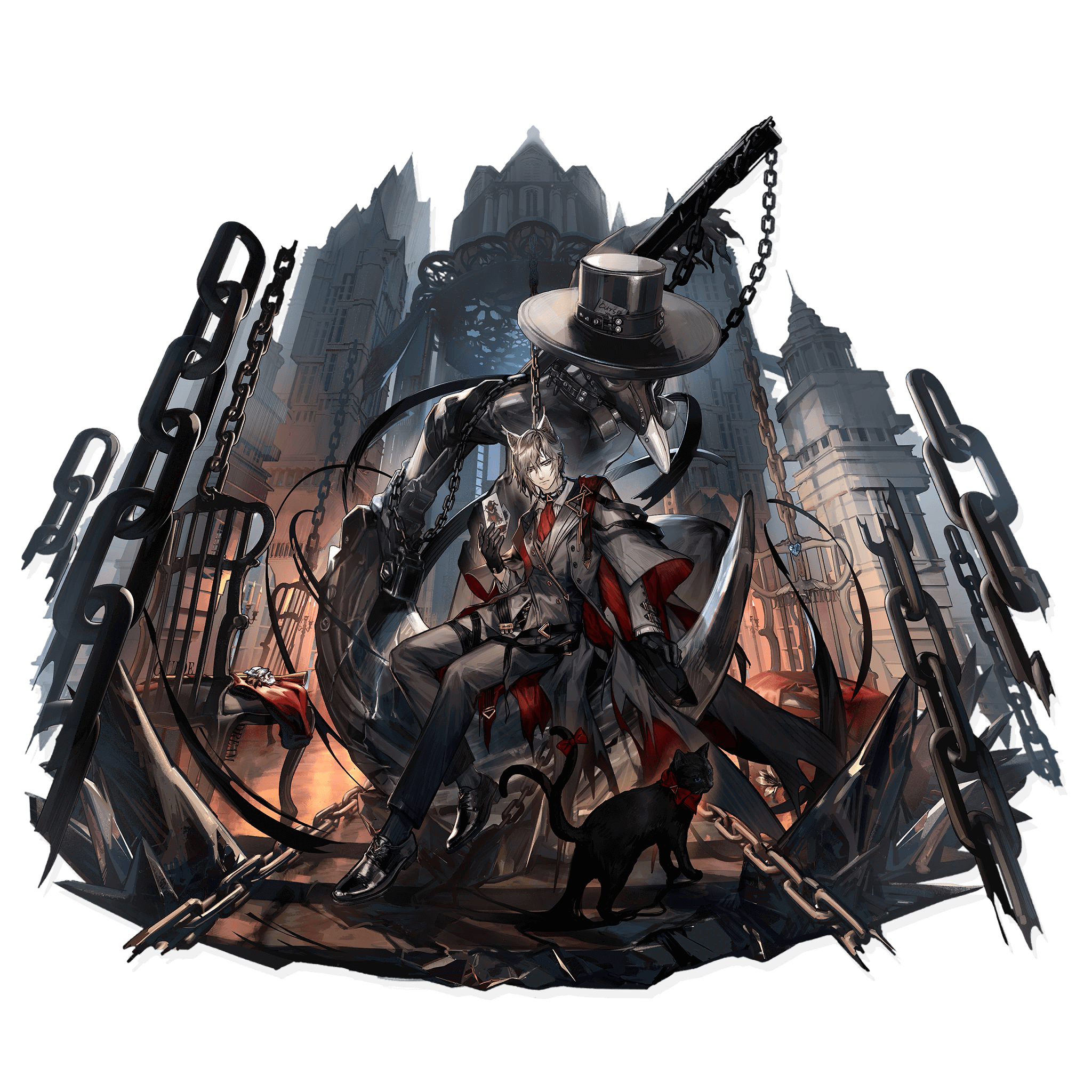
Therefore this costume is called ‘Nightmare’s Dream’ and the theme of the escape room is ‘Dreambind Castle’. His fringe, way of sitting and hand gesture (besides the card on the right hand, the hat on the left hand replaces the mask) look like the E2 art (so is the disappeared Oripathy crystals on his neck). The E2 illustration seems to be in the mental world of ‘the theatre that night and the spirits’. So the Oripathy crystals are not seen. (it can be said that E2’s appearance is of Phantom’s peak). Moreover, the introduction is: ‘The clear dream crosses reality and coexists with it’. Therefore, this costume should be something in the mind. The castle may exist as it is something of the theme, but the escape room’s decoration has been twisted and changed by the ‘nightmare’ of his heart to become what is in the costume to become a more realistic experience. If ‘Independent Blade’ describes Phantom in the outer world becoming more lucid thanks to Doctor’s help. Then this costume is his inner actions in the ‘nightmare’.
The first thing that can be seen is the plague doctor behind Phantom. This is a familiar sight in many games and literature. (This mask seems to be more of Victorian steampunk style). This will be introduced slightly here. The origin of the bird mouth mask and the clothing has been attributed to Charles de Lorme. (Plague doctors exist, except that they do not dress like this). The protective suit consisted of a light, waxed fabric overcoat, a mask with glass eye openings and a beak shaped nose, typically stuffed with herbs, straw, and spices. Plague doctors would also commonly carry a cane to examine and direct patients without the need to make direct contact with them.
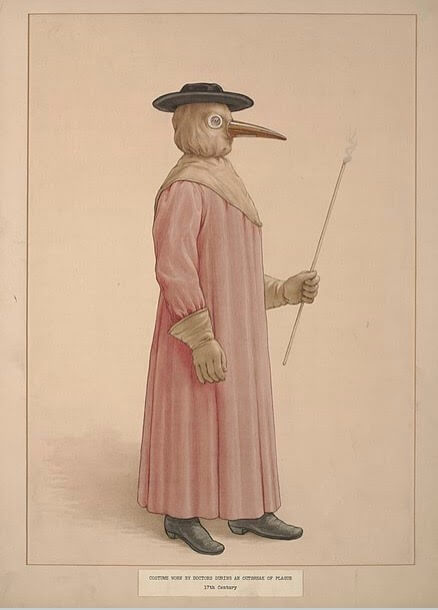
This getup had some form of protection. Due to the beliefs of people then, the plague was still punishment from god. So people thought they had to go through physical pain and punishment to fend away this ‘sin’(Some believers in penance will walk around naked, chant, and slap thorns into their backs as some kind of ‘blood-letting’ therapy). Some of these believers will be beaten by the staffs of doctors to bring ‘salvation’ to their sins. At the same time, low medical standards (even if plague doctors were the most highly educated in that era) and sanitary conditions meant that no matter how much doctors worked hard, they also cannot save many dying people. So this bird mouthed mask also became a symbol of ‘death’ and the staff of the plague doctor also became the scythe of the grim reaper.
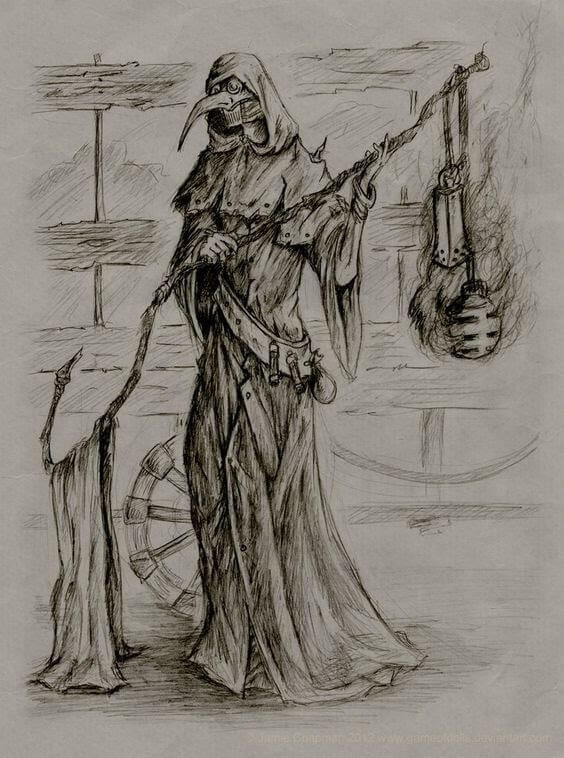
Pipe: Reference to The Pied Piper of Hamelin

It looks like a rod, but the end is flared. According to the keyword of ‘plague’ from the plague doctor, the source should be the German story of the Pied Piper. In the stories by the Grimm brothers and the 19th century English poet Robert Browning, it is known as the ‘The Pied Piper of Hamelin’
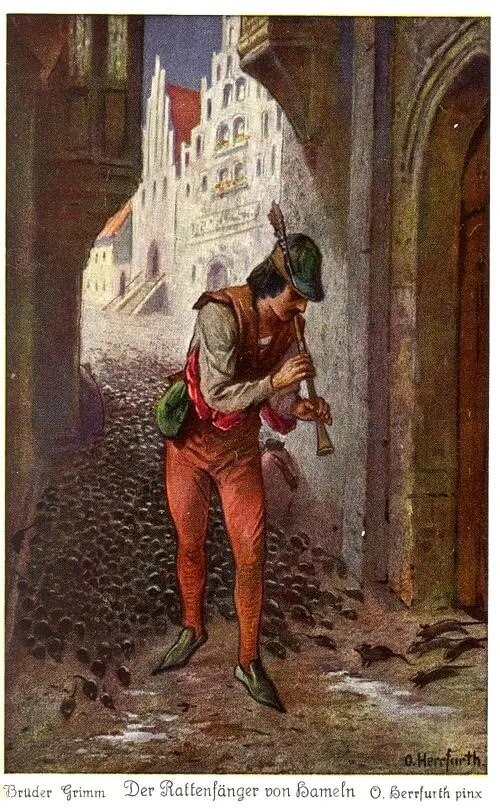
In 1284, while the town of Hamelin was suffering from a rat infestation, a piper dressed in multicolored ("pied") clothing appeared, claiming to be a rat-catcher. (t/n: on a side note, Phantom's costume is a lot more colourful than his usual clothes. Can be kind of considered to be pied.) He promised the mayor a solution to their problem with the rats. The mayor, in turn, promised to pay him for the removal of the rats (according to some versions of the story, the promised sum was 1,000 guilders). The piper accepted and played his pipe to lure the rats into the Weser River, where they all drowned.
Despite the piper's success, the mayor reneged on his promise and refused to pay him the full sum (reputedly reduced to a sum of 50 guilders) even going so far as to blame the piper for bringing the rats himself in an extortion attempt. Enraged, the piper stormed out of the town, vowing to return later to take revenge. On Saint John and Paul's day, while the adults were in church, the piper returned dressed in green like a hunter and playing his pipe. In so doing, he attracted the town's children. One hundred and thirty children followed him out of town and into a cave and were never seen again. Depending on the version, at most three children remained behind: one was lame and could not follow quickly enough, the second was deaf and therefore could not hear the music, and the last was blind and therefore unable to see where he was going. These three informed the villagers of what had happened when they came out from church.
Other versions relate that the Pied Piper led the children to the top of Koppelberg Hill, where he took them to a beautiful land, or a place called Koppenberg Mountain, or Transylvania, or that he made them walk into the Weser as he did with the rats, and they all drowned. Some versions state that the Piper returned the children after payment, or that he returned the children after the villagers paid several times the original amount of gold.
The Hamelin street named Bungelosenstrasse ("street without drums") is believed to be the last place that the children were seen. Ever since, music or dancing is not allowed on this street.
The name of Phantom's hometown, Celaiblason might be a word play on 'celebration' because it sounds alike. In both Crisscrossing Shadows and The Pied Piper of Hamelin, there is a theme of music (supposedly something for celebration) brings death and then no more celebrations afterwards.
Strictly speaking, the black cat Miss Christine is also a symbol of ‘death’ in Western countries. But due to the complications of Miss Christine’s situation, I will speculate further behind. Returning to the plague doctor and pipe, these things are far from Phantom’s image. It is as if reflecting his heart. But why show these? And when he thinks of these, then why is he sitting on the scythe of a ‘grim reaper’?
I think the images that appear here have double meanings, like how his trait is ‘Phantom in the Mirror’. Anything of his does not just have one meaning. Then with this plot, this plague doctor of his clone have double meanings that lead to ‘Punisher’ and ‘Punished’. ‘Punisher’ is easy to understand and ‘grim reaper’ is such a representation.
Words found in the costume background

The word ‘GUIDE’ is seen next to the pipe, like how Phantom’s voice can take away people’s lives. This shows that Phantom’s music lead people towards death.
The word ‘DREAM’ appears next to the chair, showing that this is indeed a ‘nightmare’. The chair on the right is different from the rest, which might be the one in the dorm animation. ‘DEDICATION’ is written there, referring to Phantom’s initial dedication to the devil and art or the judgment in his nightmare. The hat of the plague doctor has a paper writing ‘CURSE’. Similar to his E2 art, he curses everything on these bones, but is also cursed by the bones at the same time.
It can be seen that the plague doctor has the image of the ‘punished’. Its appearance is intriguing. Although it is the ‘grim reaper’ who takes lives away, but it does not hold a scythe. Its arms and scythe are held by chains, unable to move.
Chains, church, sin and punishment
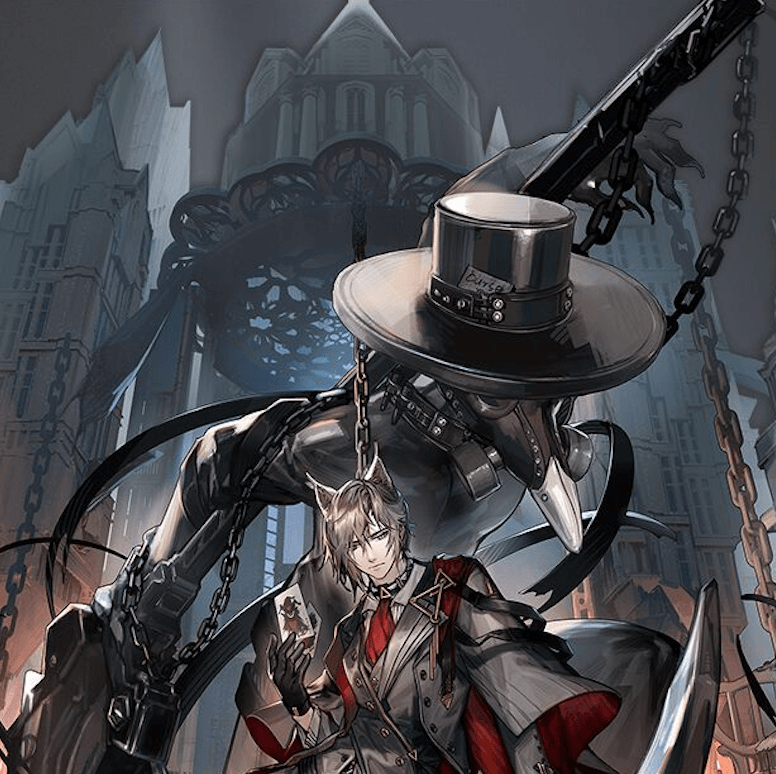
There are two meanings to these chains: One is suffering, the other is repentance. In Phantom’s Trust 1 line mentions that ‘This device embedded above my throat compresses my neck, but it is exactly what I need. Like a mask, it conceals my sins and my voice. ‘ With this, his battle line of ‘The guilty... will be punished.’ may have a new meaning: He sits on a scythe of a grim reaper without fear. Not just because he has the role of a plague doctor. He has also judged himself to be a mistaken grim reaper. Although he killed those ‘drowned people’, but he also took the lives of others. No matter whether these actions come from his heart, this is his ‘mistake’. This spoils his motive of killing. The deeper he goes into his art, he follows the devil more. So the plague doctor’s scythe and its chains are the judgment on himself from his heart. He has never denied the truth and accepts the punishment of the grim reaper. He does not seek death, but he also does not allow himself to escape and deny the past.
Whether he becomes a plague doctor who tries his best but does not wish to sacrifice lives, or wants to be cured by a plague doctor, he eventually is still a patient with ‘sin’. In the nightmare of this costume, ‘sin and punishment’ are undeniable themes. The view of his own past is the source of appearance of his mental world.
Besides the scythe and plague doctor, the other areas of this scene has many chains. Especially at the back of the three chairs. From the reflections on the scythe, there are many more chairs. Phantom is also held by many chains.
These three chairs are similar to the chairs in the mindscape of Phantom in the Crisscrossing Shadows story. Although there are three actors, but there are more than three chairs.
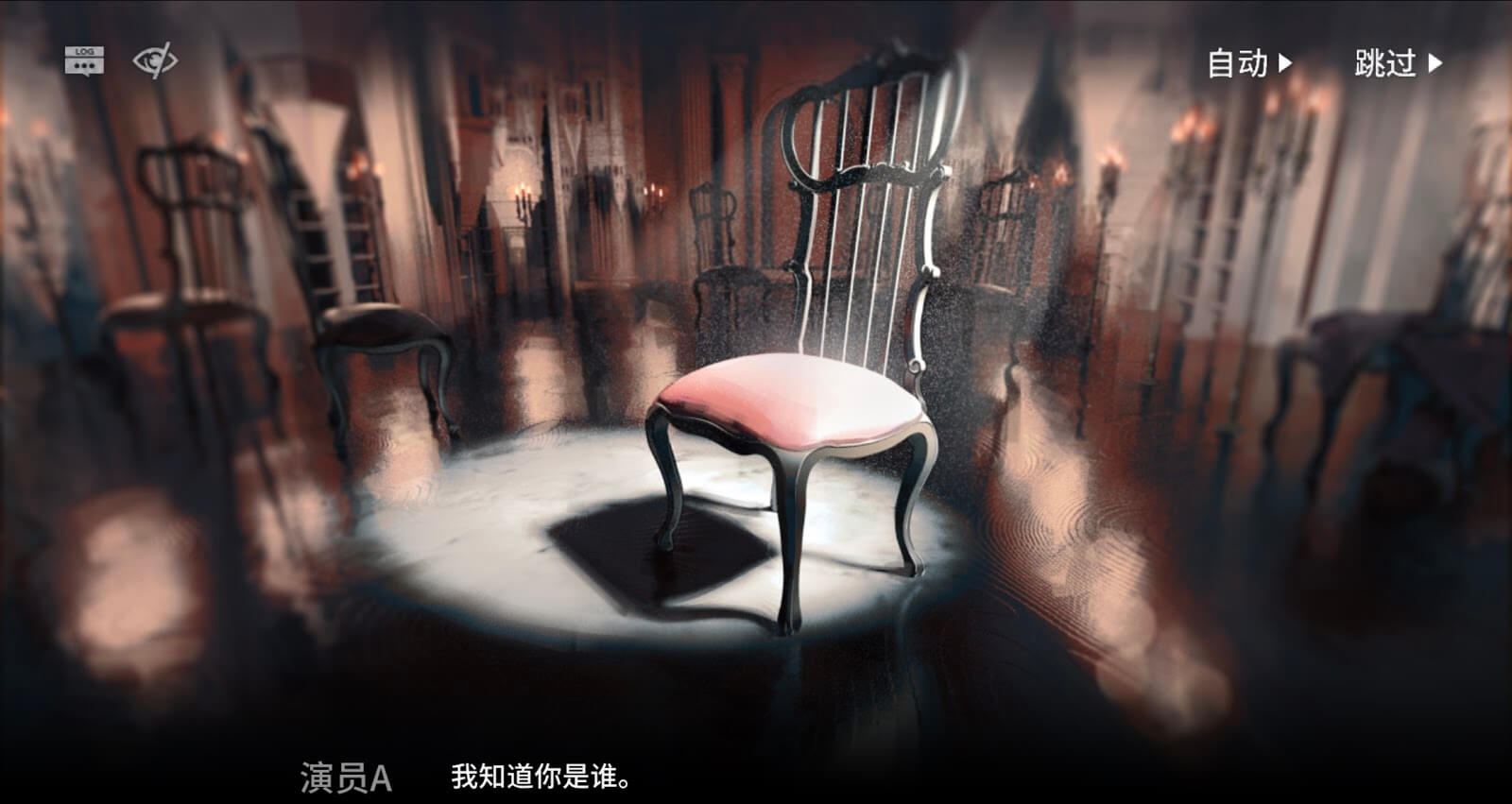
Although Actors A, B, C did not appear that night at the performance. But this changing effect seem to have the spotlight on them. So the chair of the mindscape should be the ‘actors’. In other words, these could be the ghosts haunting Phantom.

In the theme, there is cursive text that says ‘Beware of ghosts’.
Possible 'ghost' references to Phantom of the Opera:
-Musical: ‘Beware the Phantom of the Opera’ is lyrics sung in the titular song.
-Novel: Erik is often referred as Opera Ghost and signs off all his letters as O. G.
The theme of ‘ghost’ is seen multiple times. In the other three ‘Ghostbusters’ theme costumes, multiple ghosts are seen (pumpkin rabbits in Shaw’s costume, the big ghost in Glaucus’s costume, and the eyes in the box of Mayer’s costume). Only Phantom is alone in his costume, or to say, only he has the image of a ‘ghost’. Although it is not drawn, but Phantom’s former partners, the ghosts now could be like the mental world, sitting on the chairs and looking at him (shiver).
The backs of the chairs and the chains on top of it, along with the angle and colour, makes one think of prison. As if the one sitting on the chair is incarcerated. As mentioned, the body of the chains, especially when on the plague doctor, makes the whole scene look like the conflict between the plague doctor and the chair. They bind each other like the ghosts in Phantom’s dream. The ghosts haunt him and do not want to release him from the memories of the past. At the same time, his disastrous psychological state also causes more souls to gather at him, unable and unwilling to leave him.
Besides this, the location of the ‘nightmare’ has bound his will.
In Phantom’s story, I always suspected that the location of this dream is according to Phantom’s Archives 4:
We found the site of the incident that befell the troupe at the time. The site is a small rural town that was destroyed by a wave of Oripathy. Anyone who could have fled did so long ago, and now the area is completely deserted.
Too much time had passed, so we didn’t have much hope in the first place. And indeed, everything here seems to have been forgotten... Seeing this photo should make that clear enough. It’s just like one of those fabled ghost towns. All the residences, facilities, and public spaces have been preserved as is, including the troupe’s tents stationed in the park, just like in the records - the only thing that’s missing are the residents.
The live video of the troupe’s performance has been completely destroyed, and the machinery left behind is broken beyond repair. However, we did locate a main console far from the stage, where we managed to recover some damaged documents and externally backed-up data.
Despite our painstaking efforts to restore the damaged data, the contents are just a jumbled mess. The best way to describe it is as if a piece of cake was sealed within a plastic bag, then thrown into a fervent crowd at an Iberian festival. What we managed to recover is pretty similar to whatever would be left in that bag afterwards. As for the portion of the data that was sent out, the path was too vague and could not be tracked.
Whether it’s the building style or the plot, the place where Phantom sings in his dream looks like a church instead of a theatre. The stained glass windows prove this point. So this raises the question of why Phantom’s will has attachments to a church? It should be a roaming theatre due to his character, and this is not a religious place. In my opinion, the church and chair could be another epitome in Phantom’s beliefs.
In Victorian times, especially in the era of ‘The Phantom of the Opera’, the customs of religion is rather widespread. In Phantom’s clothes, there are many triangles. In Christianity, the triangle is a common symbol, representing the trinity. There are also other church related imagery with Gothic features (19th century churches are mostly built with such architecture). It is unknown if Phantom is actually religious, but perhaps after the theatre incident, he should not be believing in any god. But even if he does not follow any religion, it does not affect how the religious imagery appears in his mindscape, affecting his cognition and producing the images of ‘sin’ and ‘punishment’.
Back to the church, the stained glass in the middle and the pointed part are known as a crossing in church architecture. It is the junction of the four arms of a cruciform (cross-shaped) church.
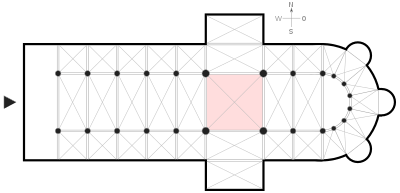
The connection of the crossing is round or pointed. Some churches will have stained glass to increase the aesthetic of the church and let light in. In the story, the light enters on Phantom’s head as he performs. Towards the east is the chancel where mass takes place. The costume and story background seems to be near the crossing and chancel. Perhaps these places are combined into one. Anyway, below the stained glass is where the location of the ‘church’ is most obvious and powerful. This is why the story starts with Phantom standing there: He is the lead actor.
Here is another question: Phantom should be acting as the owner of the castle in the costume, and also the owner of this mindscape. But from the viewing angle, neither him nor the plague doctor is standing under the stained glass, and they seem to be in the middle where the pews are in a church. Why is this so? Actually this is connected to Phantom’s self-belief in this mental world. In the story, before the mental world ends, Actor A says this.
Actor A: You should not speak. You should not sing. You should not be on this stage.
On the floor under the scythe, there are two steps. The floor texture looks like the wooden floor of a stage where the colour looks like the floor of Phantom’s E2 art and mindscape). Phantom and the ‘actors’ have left the stage where they ‘should not exist’. After losing his voice, he has also lost the position of ‘protagonist’. According to the position in the church, his position changed from a ‘preacher’ to a ‘repenter’. From a shepherd to a bloodstained lamb, mixed in the other believers, yet stared at and questioned by the other believers. Although he has the most central position in this illustration, he is not the real owner of this church shaped castle. Or at least he does not think so-- Then what is stopping him from taking action in his mindscape? It is apparent that it is the nightmarish performance. From there, we can see his Trust 2 line and short description: How did he see his actions of killing everyone in that performance?
I think that even excluding his complicated psychological activities, Phantom thinks that this is ‘wrong’.
Miss Christine
Note that her left leg melts into shadow. This is foreshadowing for Phantom’s Operator Record (special stories that will be implemented in future updates) which also further explains the backstory of his costume in the actual game lore compared to the symbolic analysis here.
Speaking of Christine, Crisscrossing Shadows confirms that Phantom is actually more like Christine than Phantom. Seeing that he's the one who hears the voice of the devil and is haunted.
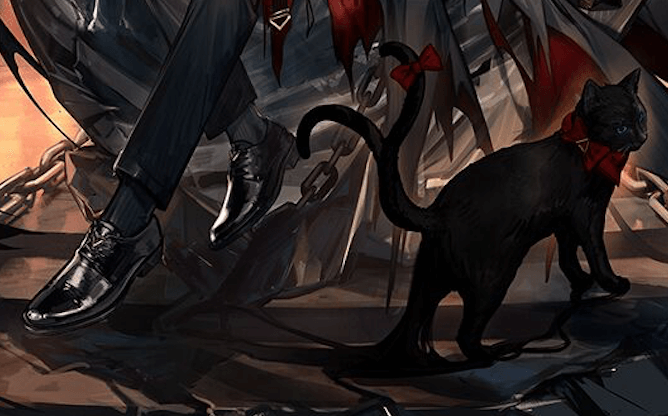
Joker cards
The final detail is the joker playing cards that Phantom holds.
The earliest joker cards are not part of the standard cards. But it was later on added as a universal card. Around 1860-1880, the joker card starts existing. The joker picture resembles the 0 and Fool card in the arcana of the Tarot too. Both are ‘non-standard cards’. Interestingly enough, the Fool’s position represents freedom, genius, unlimited imagination and creation. When reversed, it represents stagnation, chaos, nothingness, and negative emotions. Why do these cards appear in Phantom’s mindscape, it is self-explanatory.
Seemingly controlling double trump cards, but actually a puppet branded as the ‘fool’ by fate. Occupying a castle, yet has fallen to a ‘criminal’ judged by the court. Wants to cure himself, yet does not know how to get about it. A ‘grim reaper’ who cannot return, only able to ponder and struggle in a nightmare that is deeper than any other ordinary dream and wishes for a way out. If he is really the ghost of this game, then ‘killing’ others may bring him momentary respite. Phantom’s personality is just like his past. Tragic but human.
To some extent, his codename of ‘Phantom’ is a double play on his fate and self-belief. On the surface, this person who yearns for freedom and respects lives has become a puppet of the devil. But on a deeper level, this puppet and shadow, who should have succumbed to a more powerful and unpredictable force, sticks to his beliefs all the time. He waits for the opportunity to escape his own struggle. Judging from the gradual progress of Phantom and Doctor’s words,, it is obvious that this kind of struggle is no longer murky and futile.
The two joker cards existing together, who can confirm that the one with the cards will not deviate from the right path? Maybe breaking the cocoon to become a butterfly only needs time, or an opportunity. Before this, all the suffering will not make you give up.
Because some day, the nightmare will dissipate. There will be a day when you can be reborn from your personal hell.

